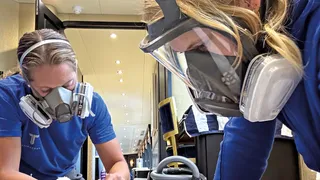How to win the fungi war — and prevent it getting a hold in the first place.
Raise your hand if you’ve been on a boat with mold growing on board. That’s all of us, yet somehow the problem gets ignored. Mold is a soft, fuzzy or slimy growth that appears on rotting material due to moisture and decay. In nature, it plays a helpful role in breaking down organic material, but it can cause serious damage and present health concerns. No one wants that lingering musty smell, sick guests and crew or expensive repairs.
Since yachts are wet by definition, it’s hard to escape what comes along with the humid environment. Most of us chase summer around the globe, meaning we are constantly in warm climates. Couple that with inevitable leaks on board and mold is almost unavoidable. It can grow on virtually any surface and spreads quickly. Disturbing it causes the spores to spread, and the problem is usually deeper than what you see on the surface.
Since it can be difficult to fully remove, sometimes infected surfaces must be replaced. You can imagine the hassle if it gets into walls, under marble, up in the headliner or throughout the AC ducting. Leaks can cause unseen damage that you might not discover until it gets out of hand. Many captains and owners are intimidated by the scope and cost of the issue, so they choose to remain in denial and Band-Aid it instead of investing in a proper fix. However, this approach puts everyone at risk with health concerns and degrades the value of the boat.
The best way to get to the bottom of a mold infestation is to call licensed and insured air quality professionals. They have the experience, certifications and equipment to remove all traces of mold. Unlike crew, pros have the resources to handle the clean-up without getting sick. They can help prevent future dilemmas by educating crew on mold prevention and installing permanent solutions such as airlocks.
Before the professionals arrive, there are steps that crew can take to improve air quality on board. Most importantly, remove as much moisture from the environment as possible. Keeping bilges empty, drying out showers and quickly drying wet laundry are simple and free ways to cut down on dampness. Worthwhile investments include dehumidifiers and HEPA air purifiers, which come in a range of sizes and price points — some as little as $50. These work wonders to lower humidity and clean the air. It’s equally important to maintain air handlers to prevent clogs and overflow. If crew must clean a serious mold outbreak, proper PPE is critical.
At the end of the day, avoiding damage and health concerns comes down to proper care of the boat. Without question it’s easier, cheaper and safer to prevent mold growth than it is to fix it once it’s out of control. If you suspect mold growth, the best solution is to call in the professionals to safely neutralize the problem and install equipment to help prevent future outbreaks. However, it’s the crew’s responsibility to maintain both the integrity of the vessel and the health and safety standards on board. Cleanliness is everything!

